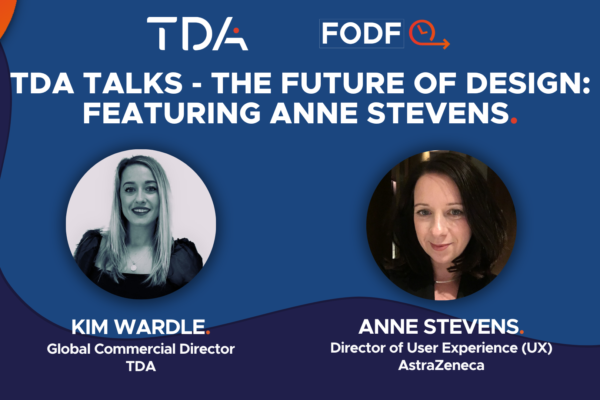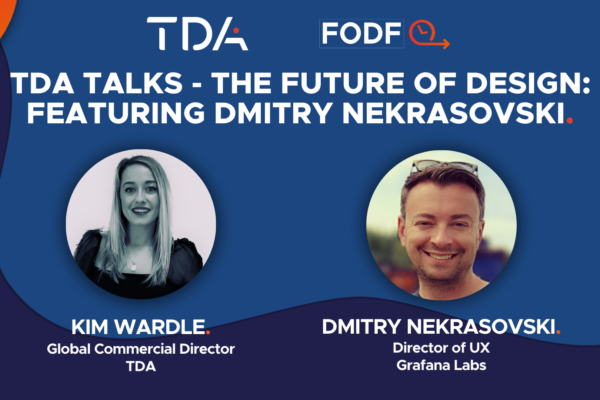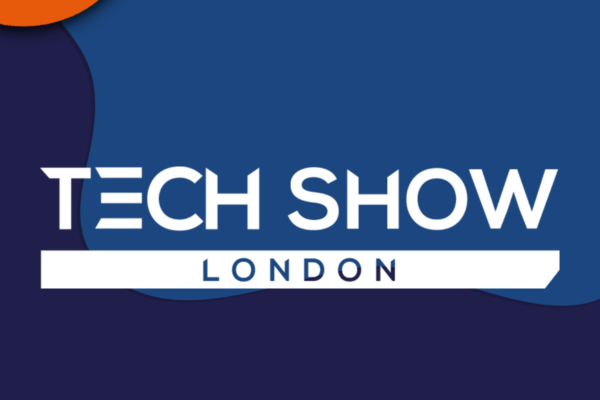Over the ten years we’ve been constructing design teams for top brands, we’ve found that there are six steps creative and design leaders looking to build a creative design team should consider to ensure the pursuit is a success.
These steps helped us create successful design teams for global brands like American Express, eBay, Goldman Sachs, Frog Design, Citi bank, Morgan Stanley, Coinbase, AOL, HUGE and BlackRock – and they’ll no doubt help you out too. Read on to discover these steps and guarantee that the design team you’re putting together reaches its full potential, smashes its goals, and works effectively as a unit.
- Define your company/project vision
- Build your own skills matrix Roadmap your way
- Understand the link between team size and creativity
- Consider both core and supplementary roles (and how you’ll structure them)
- Consider experience and cultural fit, not just qualifications
Start by defining your creative vision
When building out a design team, start by defining your strategic vision. Do you really need to grow a design team? If so, why?
Having a clear concept of your new design team’s purpose will make constructing the team itself much more straightforward. It also has the added benefit of ensuring every team member knows what’s expected of them.
Here are some key questions that’ll get your creativity flowing and help you concretise the vision for your creative teams:
- What are you hoping to achieve by putting this team together?
- How will this team achieve its goals?
- What do your current teams need support with?
- What skills will be needed to deliver your project to success?
- What personality types will you need in your optimal team?
- What sort of experience would be valuable to bring to the team?
Build your own skills matrix
There are multiple core and supplementary skills which make up a design team, and it’s essential to keep track of them all. We’re not assuming you’re starting from scratch when building a creative team, nor do we think you need all the skills present at every stage of a project. This means you need a way to assess your existing staff’s core skills and competencies to see who you need to hire and when – and that calls for a skills matrix.
A skills matrix is quite a grand title for something that’s relatively easy and quick to complete. Just list the names of your current creative team in cells along the X-axis of a spreadsheet, and then on the Y-axis list, input each of the skills you think you need to be able to tap into.
Then put an ‘X’ against any skills that each employee has competency in. Any remaining boxes without an ‘X’ at the end of the exercise are your current skills gaps. Here’s an example:
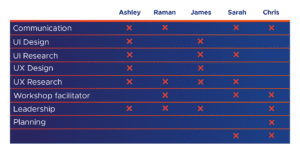
Completing this exercise will ensure you have precisely the right skills in your design team to succeed both now and in the future. Keep this document on file so that if a staff member leaves or the scope of a project changes, it’s easy to remind yourself how this will impact your creative team.
Roadmap your creative process
Road mapping is an essential strategic process for taking your initiative from vision to reality.
A ‘roadmap’ is a living document that articulates your processes, breaking down your vision into a visual representation of timescales, information flows, and – pertinently when building a creative team – resource allocation.
Here are eight steps to take to ensure you have all the information you need to create a roadmap:
- Remind yourself of the problems or challenges you’re tackling with this project – why do you need to formulate a new strategic vision in the first place?
- Break that vision down into objectives. What will success look like? What are your goals for the project?
- Agree on the timescale for your project, allowing for onboarding of teams and finessing the work.
- Insert critical milestones such as sprints and launches into your timeline.
- Assess your capabilities. Who’ll be working on the different tasks, and do you have any gaps in your team’s skills that need filling? (Your skills matrix will help here!).
- Identify the stages that’ll require collaboration between other teams or stakeholders.
- Unless your roadmap is very high-level, you might want to capture actions and label them with ‘now’, ‘next’ and ‘later’.
- Generate your roadmap. If you need help with this, there are many fantastic road mapping tools available like Asana and Monday.
TDA TIP: Whatever your overall goal, break it down into bite-sized steps to make it manageable.
Building a clear roadmap is essential to enable the creative brains in your team to work together. If you don’t have the time or skillset to outline this process yourself, make it your priority to hire someone who can.
Understand the link between team size and creativity
You could be forgiven for thinking that a creative design team needs to be large, but that’s not necessarily the case. Smaller teams have actually been proven to be more creative than their larger counterparts, particularly when it comes to disrupting and innovating.
Analysis for the Harvard Business Review uncovered a nearly universal pattern: larger teams tended to be most effective at developing and furthering existing ideas and designs; smaller groups tended to disrupt current ways of thinking with new ideas, innovations, and opportunities.
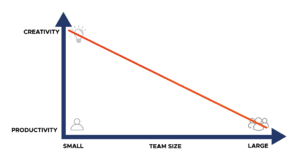
This data is backed up by Scientific American, Bloomberg, and others, suggesting bigger isn’t always better.
For us, it always comes down to finding the right size team for the job at hand. Whereas some projects need plenty of manpower to get them over the line, others will benefit from this ‘small and mighty’ approach. But one thing is sure – don’t assume smaller teams can’t out-innovate larger ones.
Consider both core and supplementary roles (and how you’ll structure them)
It’s important to remember that a one-size-fits-all approach simply doesn’t work for design teams.
You need to take a broader view and connect your creative vision to the fundamental skill sets needed to deliver projects successfully. This may involve placing several core roles together with auxiliary functions which complement and support their work.
- Design Leaders
- UX Designers
- Product Designers
- Content Strategists
But how you assemble these core skills – and how you bolster them with supplementary roles – is up to you, and there are pros and cons to the most common models:
Generalist teams
Some teams are made up of generalists with broad skill sets. Generalist teams can be beneficial because every member understands what’s required to complete the project and can work towards the end goal together. The possible downside is if you find you need more specialist knowledge part of the way through the project – you’d then have to hire a new team member on the fly.
Specialist teams
A team of specialists sees each person tightly focused on their area of expertise. The benefit of this is that you have people with a profound understanding of their role and specialism. But, there’s a risk they’ll be less able to collaborate with others and see the bigger picture.
Hybrid teams
A hybrid team can deliver the best of both worlds – a deep understanding of critical core skills combined with generalists who can better oversee and bring the different elements of a project together. The benefits are clear, but the perceived downside is that this type of team is more complicated to build and manage.
Supplementary roles – don’t forget these
Supplementary roles you might need to consider hiring for include:
- UX copywriters
- Information architects
- Visual designers
- Audio designers
- Design ops
- UX Researchers
- UI Designers
There’s contention in the industry about how vital these supplementary roles are to overall project success. For example, many believe you only need a design operations specialist when building larger teams – in smaller teams, they’d be a little like a third wheel.
While that debate is ongoing, it’s clear to us that you need to consider which of these ‘extra’ roles and skill sets will best suit your current project or company vision.
If you need any help understanding what these supplementary roles can bring to your design team – or if you’re interested in how to best structure your teams – talk to TDA today.
Consider experience and cultural fit, not just qualifications
When hiring to build design teams, managers usually list the key competencies, experience, and certifications required to select candidates for an interview. This helps them define the role, narrow down the pool of talent, and makes hiring more efficient. Often, certification is used as a filter mechanism to weed out unsuitable candidates during the process’s early stages. But when comparing candidates, be wary of placing more value on certifications than you do on experience.
Big brands like Google used to require every candidate – including their developers – to be educated to degree level. However, it soon became apparent to the management teams that this arbitrary condition meant they missed out on meeting lots of talented candidates. Suffice to say, their policy has now changed.
The lesson here is that – if you’re interested in hiring the best talent on the market – broadening your search criteria and looking for real-world experience, coupled with a portfolio or resume full of evidence of technical skill, is the way forward.
You also need to consider how your new hire will fit within the team from a cultural standpoint. You may find, for instance, that the project or brand you’re working on necessitates a team of creatives with diverse ethnic backgrounds. Finding the right cultural fit is just as important as finding someone with the required skills and experience, so spend time considering it too.
Want to continue the conversation?
By following the steps above, you’ll have a concrete idea of how you want your design team to be constructed and what you’d like it to achieve. Here at TDA Creative, we have the expertise and connections to help you bring that structure to life.
Get in touch with our team of experts to learn more about our process and discover how we can help you.



